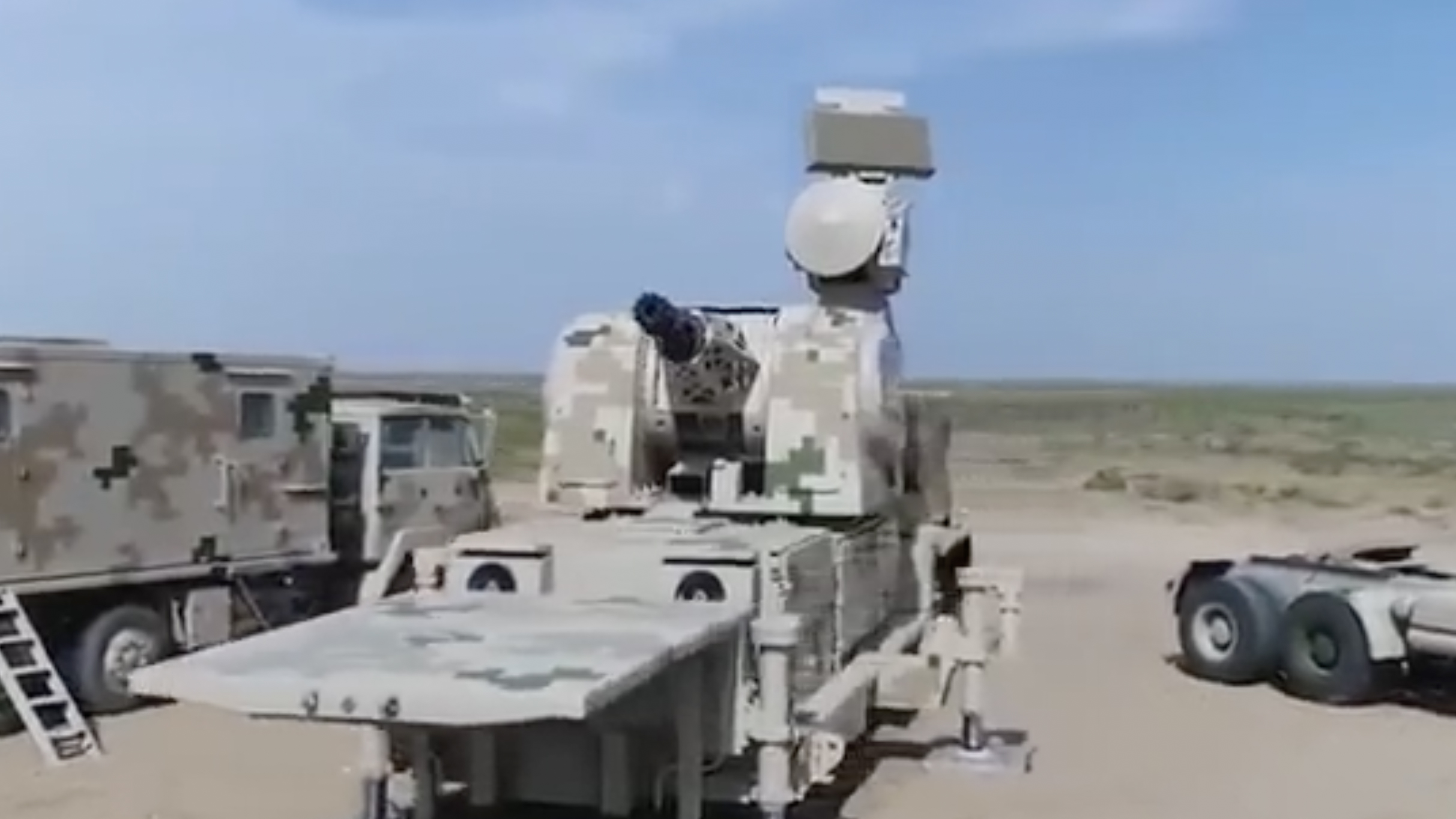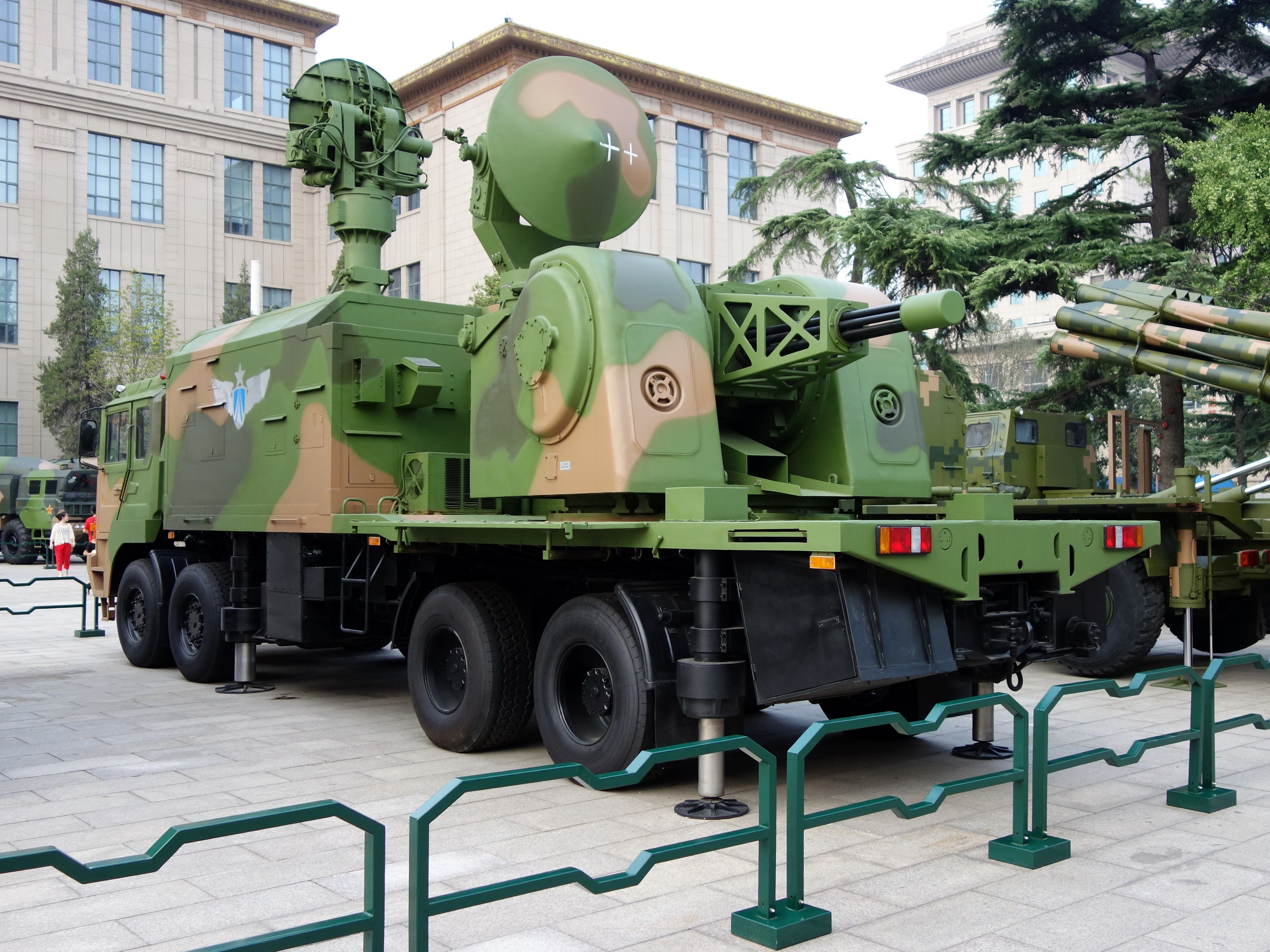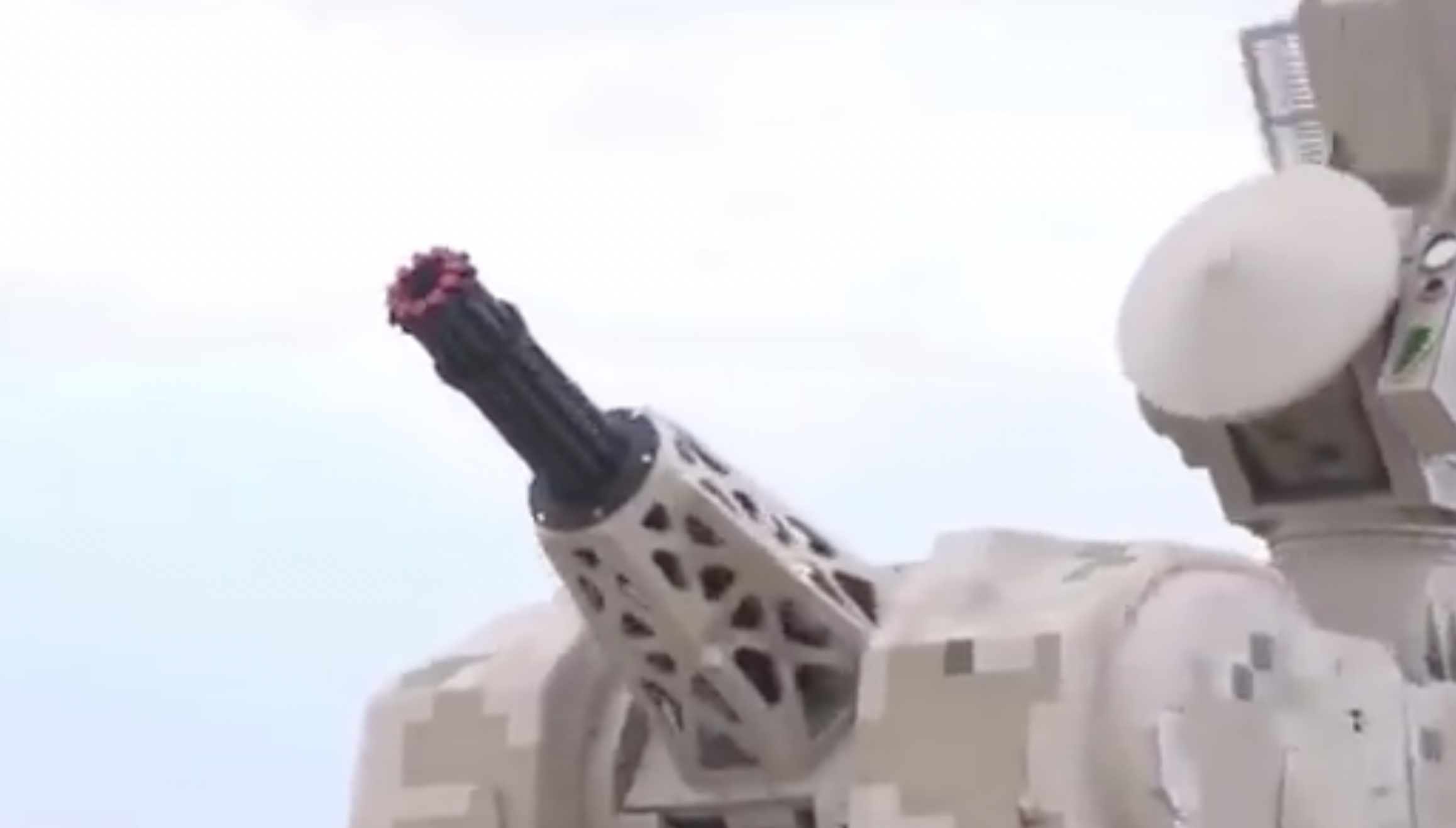China has unveiled a new 11-barrel version of its ground-based 30mm air-defense system, with a trailer-mounted adaptation seemingly optimized for the point-defense of key installations. The new weapon, and its seven-barrel predecessor, are both based on existing shipborne anti-aircraft artillery systems. Although the exact capabilities of the new weapon are unconfirmed, the 11-barrel mobile Gatling-style cannon would be effective against low-flying helicopters, fixed-wing aircraft, and cruise missiles, as well as offering a powerful counter to the growing threat posed by small drones. Furthermore, it could even fulfill a role similar to the U.S.-developed Centurion Counter-Rocket, Artillery, Mortar (C-RAM) system.
Video footage of the trailer-mounted gun appeared in the run-up to Airshow China in the southern city of Zhuhai, which formally opens tomorrow and runs until October 3. The system has been developed by the NORINCO Group, a Chinese state-owned defense corporation that produces a wide array of artillery and small arms, as well as various types of munitions.

The new ground-based system, the designation of which is not currently known, has been developed from the Type 1130 shipborne anti-aircraft artillery mounting, itself apparently inspired by the Dutch Goalkeeper close-in weapon system (CIWS, pronounced “sea-whizz”), which uses the same size ammunition as the A-10 Warthog’s GAU-8 Avenger cannon. The Type 1130 is one of several types of gun-based naval CIWS developed by China. Others include the smaller Type 730 that features a seven-barrel 30mm cannon as well as an enormous 20-barrel weapon that appeared earlier this year and which is apparently still in the developmental phase.

The Type 1130 was first seen on China’s first aircraft carrier, the Liaoning, and has also been installed on other Chinese warships, providing a last line of defense, primarily against incoming anti-ship missiles. These same capabilities lend the Type 1130 gun to various land-based roles, too.
The previous seven-barrel Type 730 has also been adapted as a truck-mounted version, known as the LD-2000, another NORINCO product. Primarily intended to destroy cruise missiles and precision-guided bombs, the LD-2000 is fielded by the People’s Liberation Army (PLA) as the last line of defense for key installations, such as command posts and radar sites. Some versions of the system also add six TY-90 infrared-guided missiles to provide another means of prosecuting aerial targets. A fire-control radar and electro-optical sensor are included on the truck, which can operate independently or as part of a group.

The Type 730 weapon used in the LD-2000 has a reported rate of fire of around 4,000 rounds per minute and a maximum range of about 1.8 miles, although targets are more likely to be engaged at between 0.6 miles and 1 mile.
In comparison, the 11-barrel Type 1130 offers a similar engagement range but is credited with a rate of fire of 10,000 rounds per minute, according to local media accounts, meaning it should provide a significantly greater destructive effect or better sustained fire.

A degree of commonality between a naval CIWS and a ground-based air-defense system is not without precedent, of course. The ubiquitous six-barrel 20mm Vulcan employed in the Phalanx naval CIWS was also used in the Vulcan Air Defense System (VADS) that was introduced into U.S. Army service as long ago as 1967. More recently, the same basic gun was adopted under the Counter-Rocket, Artillery, Mortar (C-RAM) program that created the aforementioned Centurion, although this is a very different concept and yielded a much more cumbersome and complex system than VADS. In Taiwan, meanwhile, thought has been given to adapting Phalanx to defend against potential Chinese attacks, with a land-based version to protect its airbases, as you can read about here.
It’s unclear whether the new ground-based version of the Type 1130 is intended to perform a similar role to the existing LD-2000, which is primarily concerned with destroying air-launched weapons, and other cruise missiles, or if it’s intended to have a broader mission spectrum, encompassing the C-RAM mission. The latter is at least a possibility, which could make the new system something like an equivalent to the U.S.-designed Centurion system.
The Centurion C-RAM system:

In the past, The War Zone has looked in detail at the Centurion, and you can read more about it, and see it in action, here. The Centurion was rushed into service after a crash development program in 2004, to meet an urgent need to defeat rockets and other projectiles during the insurgency in Iraq.
As a point-defense weapon, Centurion is employed in close proximity to friendly forces, typically defending fixed installations such as military bases or even the U.S. Embassy in Baghdad. Another role is to provide a lower tier of defense to protect more advanced and longer-range air-defense systems, such as the Patriot.
Employing a version of the well-known 20mm Vulcan cannon, which is used in numerous American fighters built over the decades from the F-104 to the F-22 Raptor, the Centurion puts up a wall of fire to swat lower-end artillery shells, mortar rounds, and rockets.
While a 30mm cannon, as used in the Chinese CIWS offers greater destructive power and range than the 20mm ammunition used in the Phalanx and its land-based iterations, regardless of caliber, these kinds of weapons all have a fairly limited radius. But when fielded as part of a multi-layered air-defense system, or as a point-defense solution for a particular installation, then that’s not necessarily a problem. Having radar and electro-optical sensors on the same truck chassis means the Chinese system is self-contained and doesn’t have to be plugged into a larger network, although that could be advantageous in some scenarios.
The particular ammunition used in the new Chinese system would also help determine its lethal radius. To ensure that the Centurion’s own fire doesn’t cause destruction to the surrounding area, a special Multipurpose Tracer-Self Destruct (MPT-SD) round is used, which lack the range and ‘stopping power’ of the tungsten-cored armored piercing discarding-sabot (APDS) round used in the naval Phalanx. It could be that the Chinese system makes a similar tradeoff, or it may be that the original non-self-destructing ammunition is retained.

The proliferation of drones is also a likely driver behind the development of the new 11-barrel system. The threat posed by swarming drones is one that has not gone unnoticed by China, which is one of the leading players in that field. Loitering munitions are in the ascendancy in the Asia Pacific region, with the Israeli-made Harop, in particular, proliferating there in both land and sea domains, and with Taiwan also developing loitering munitions of its own. Moreover, the hurdles to exporting a counter-drone system are likely fairly low and, especially after the experience of the Nagorno-Karabakh conflict last year, this is a threat that is fast becoming a high priority outside of China, too.
Whatever role the new Chinese truck-mounted system is intended to fulfill, it’s clear that, if adopted for service, it would offer capabilities in excess of those of the current LD-2000, at least as far as the gun armament is concerned. Equally, there is no reason why short-range surface-to-air missiles couldn’t be added, as on the earlier system, to provide another option against low-level aerial threats.
In fact, the continuing Chinese focus on short-range air defense (SHORAD) systems that can detect, track, and engage smaller targets in all weathers, is in stark contrast to the U.S. approach, where this class of weapon has been neglected since the end of the Cold War. This is of particular concern as the drone threat continues to proliferate and it’s a topic that we have discussed in depth in the past.
Meanwhile, there is a growing interest in C-RAM solutions, which could have prompted NORINCO to market this system now. As well as Centurion, solutions include other larger caliber automated gun systems, as well as new directed energy (laser) C-RAM systems, and the missile-based Israeli Iron Dome. As far as laser air-defense systems are concerned, NORINCO also offers a truck-based solution — in this case, intended primarily to destroy low-flying drones:
For now, it’s not certain whether the new ground-based 11-barrel 30mm weapon will enter PLA service, or if it’s actually aimed primarily at the export market, but a system like this makes perfect sense as a rapid means of countering a variety of low-altitude threats in the region, as well as being broadly applicable in other potential conflict zones, too.
Ultimately, it is another indication of the seriousness with which Beijing takes the proliferation of aerial threats, with an impressive arsenal of air-defense systems that can address threats ranging from high-speed, high-altitude air-breathing aircraft, all the way down to air-launched missiles, drones, and potentially now also low-end threats like shells, mortar rounds, and rockets.
Contact the author: thomas@thedrive.com
